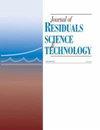A Microfluidic Colorimetric Biosensor for Chlorpyrifos Determination based on Peroxidase-like CuFe2O4/GQDs Magnetic Nanoparticles
引用次数: 13
Abstract
High-precision and miniature biosensors are in urgent demand with respect to the organophosphorus pesticides used extensively in agriculture, especially for Chlorpyrifos. In this study, the novel CuFe2O4-Graphene Quantum Dots (CuFe2O4/ GQDs) Magnetic Nano-Particles (MNPs) was prepared to amplify color signal as peroxidase mimetic using one-step hydrothermal method with electrostatic adsorption. Further combined with well-designed microfluidic chip containing enzyme inhibition reaction, color reaction and UV spectrophotometric detection areas, a colorimetric biosensor was developed based on CuFe2O4/GQDs for Chlorpyrifos determination. Experimental results of the biosensor displayed a linear range from 3.2 × 10–8 M to 6 × 10–7 M with a correlation coefficient of 0.99258 under the optimized conditions, and the Limit of Detection (LOD) of 1.07 × 10–8 M based on S/N = 3 and the sensitivity of 855.26 (absorbance) per 1 mM. Great advantages have been exhibted in the Microfluidic colorimetric biosensor due to the small volume, and high precision for determination of low concentrations of organophosphorus pesticides, largely simplifying the tedious operation and lowing LOD, which is great benefit to the further development of low-cost, portable and high-precision biosensors.类过氧化物酶CuFe2O4/GQDs磁性纳米颗粒微流控比色生物传感器测定毒死蜱
农业中广泛使用的有机磷农药,特别是毒死蜱,迫切需要高精度微型生物传感器。本研究采用静电吸附一步水热法制备了新型CuFe2O4-石墨烯量子点(CuFe2O4/ GQDs)磁性纳米粒子(MNPs),作为过氧化物酶模拟物放大颜色信号。进一步结合设计好的含有酶抑制反应、显色反应和紫外分光光度检测区域的微流控芯片,开发了基于CuFe2O4/GQDs的毒死蜱比色生物传感器。实验结果显示的生物传感器的线性范围从3.2×M可达6×10 - 7米的相关系数0.99258结果在优化条件下,和检测极限(LOD) 1.07×换M基于S / N = 3和855.26的敏感性(吸光度)/ 1毫米。伟大的优势一直在exhibted微流控比色生物传感器由于体积小,精度高,测定低浓度有机磷农药,大大简化了繁琐的操作和低LOD,这对于进一步发展低成本、便携和高精度的生物传感器是非常有利的。
本文章由计算机程序翻译,如有差异,请以英文原文为准。
求助全文
约1分钟内获得全文
求助全文
来源期刊

Journal of Residuals Science & Technology
环境科学-工程:环境
自引率
0.00%
发文量
0
审稿时长
>36 weeks
期刊介绍:
The international Journal of Residuals Science & Technology (JRST) is a blind-refereed quarterly devoted to conscientious analysis and commentary regarding significant environmental sciences-oriented research and technical management of residuals in the environment. The journal provides a forum for scientific investigations addressing contamination within environmental media of air, water, soil, and biota and also offers studies exploring source, fate, transport, and ecological effects of environmental contamination.
 求助内容:
求助内容: 应助结果提醒方式:
应助结果提醒方式:


